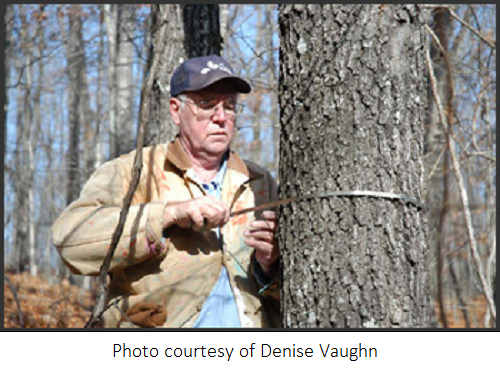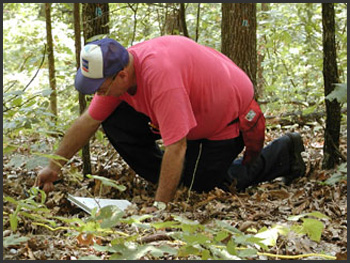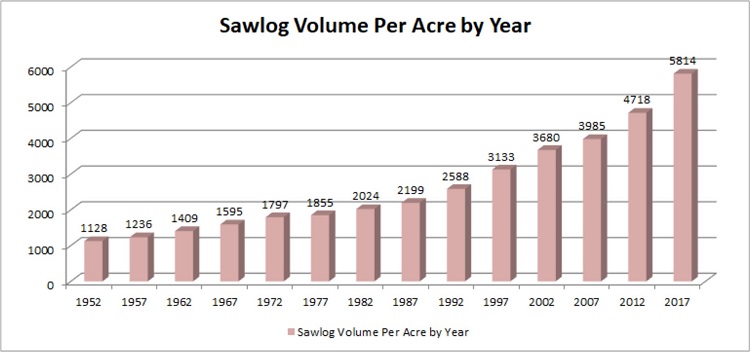L-A-D Foundation - Land Stewardship in the Missouri Ozark Highlands Since 1962
L-A-D Foundation - Land Stewardship in the Missouri Ozark Highlands Since 1962

Pioneer Forest's Ongoing Research
Continuous Forest Inventory
 The method of establishing a long-term data set for Pioneer Forest was derived in part from the work of the Ford Forestry Center, of Michigan Technological University, south of L'Anse, Michigan through the establishment of permanent sampling plots designed to measure growth of northern hardwoods. For a discussion of this system see Stott (1966) and also Meteer (1966). The technique is to measure change and growth through comparable measurements on the same trees in the same plots, in order to be representative of the forest as a whole, as well as various overstory and understory components (Meteer 1966). This technique was chosen in order to provide a true and representative sampling large enough to accurately answer questions regarding any part of the forest.
The method of establishing a long-term data set for Pioneer Forest was derived in part from the work of the Ford Forestry Center, of Michigan Technological University, south of L'Anse, Michigan through the establishment of permanent sampling plots designed to measure growth of northern hardwoods. For a discussion of this system see Stott (1966) and also Meteer (1966). The technique is to measure change and growth through comparable measurements on the same trees in the same plots, in order to be representative of the forest as a whole, as well as various overstory and understory components (Meteer 1966). This technique was chosen in order to provide a true and representative sampling large enough to accurately answer questions regarding any part of the forest.
Particularly for long-term projects this method makes it possible to compare growth figures as well as the developments and changes occurring within the forest. Once installed these permanent plots are subject to the same kind and intensity of treatment as applied to the forest surrounding them. Doing so ensures that data from the plots reflects the overall management of the forest.
Permanent research plots, one for each 640 acres (260 hectares) of the forest, were established in 1952 to initiate the continuous forest inventory. These plots measure 0.2 acres (0.08 hectares) in size. Following this first measurement, one additional plot for each 640 acres (260 hectares) was established and the first measurement of the total number of plots began in 1957. Initial information was collected from all trees within each permanent plot having a diameter at breast height of 5 inches or greater. Each tree measured was also numbered and the species recorded, along with the merchantable height to the nearest two-foot class, percent soundness, and tree condition. Today, there are 486 (0.2 acre) permanent plots which are remeasured every five years. This intensive effort provides a continuously updated dataset on the dynamics of growth and development for understory and canopy trees within a forest managed by the single-tree selection harvest technique.
Addition to Our Research Design
Beginning in 1992 we improved our research efforts in two ways. With initial help from the University of Missouri and then with assistance from the USDA, Forest Service, North Central Research Station, we have begun to collect an additional data-set from the permanent plots. Beginning with the 1997 inventory year we also have accounted for all individual trees between 1.5-5.0 inches dbh; all these trees are counted and measured, though not numbered on the plot.
Also beginning in 1992 we started collecting more specific regeneration information on seedlings. This data-set is a subset of our permanent plot data, and centers around 100 1/50th-acre nested plots where we are collecting information for all woody species from the groundcover up to 1.5 inches dbh.
Both of these studies provide an indication of the more specific dynamics operating within this management system which retains all age classes and continually grows into that system the individual trees necessary for the sustainability of economic production as well as biological replacement and regeneration.

Photo courtesy of Denise Vaughn
Results From Our 14th Continuous Forest Inventory in 2017
Pioneer Forest staff measured 448 1/5-acre plots and more than 14,000 individual trees. This inventory marked the first use of sophisticated new measurement tools and techniques, including the use of laser calipers for measuring small-end diameters and laser clinometers for estimating merchantable tree heights. These two tools were critical for obtaining more accurate tree volume estimates.

As expected, forest volume significantly increased from the last measurement in 2012. New equipment has resulted in the most accurate inventory to date. The standing volume for the 2017 inventory was 5814 board feet per acre (bf/ac). This increase of 1096 bf/per acre represents a 23% increase in standing volume when compared with the 2012 adjusted inventory, which showed 4718bf/acre.
© 2013-2023 L-A-D FOUNDATION ♦ 725 KINGSLAND AVE., SUITE 100, ST. LOUIS, MO 63130 ♦ 314-621-0230 ♦ EMAIL: INFO@LADFOUNDATION.ORG
PIONEER FOREST ♦ PO BOX 497, SALEM, MO 65560 ♦ 573-729-4641
♦ SEE PRIVACY POLICY
This site maintained by Craig Technology Consulting • 201 E. 4th St. • Salem, Missouri 65560 • PH 573.453.2322